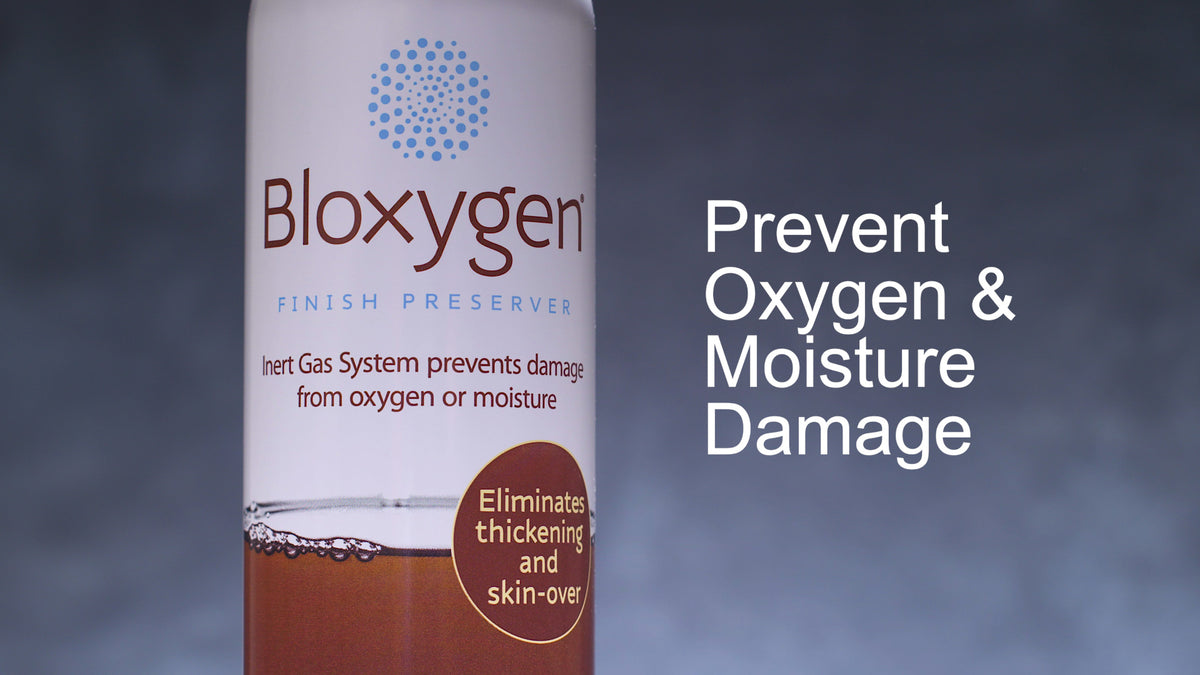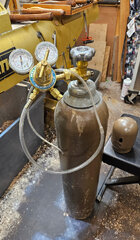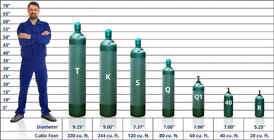@John K Jordan, when you have a moment, could you show some photos with an outline of your argon delivery system? I've hemmed and hawed over the years of setting up something more cost effective than Bloxygen cans, but haven't done so. The argon bottle, a regulator, dispensor hose... it has all been a bit vague to me how to set something up without doing/buying something unneccesary. I think plenty of folks would appreciate your effort to show it. Thanks!
I haven't thought too much about it in recent years because I've dedicated myself to Tried & True products which have not had issues with product loss in the can. A pint can not only goes a long way, but lasts a long time after opening. But if I ever go back to home brew wiping varnish, I'll need a system (i.e. Bloxygen-like) to prevent product loss.
Steve asked this question elsewhere but I thought it would be better to answer in a separate thread.
Here's the Bloxygen web site with more info as to using inert gas:

Bloxygen - Inert Gas Preservation
Save your leftover paints, finishes or food from getting ruined by oxygen or moisture. Simply spray, seal and store for up to 10 years. Never have hardened paint or rubbery finishes ruin your day. Safe for food, coffee, cannabis. Tested by manufacturers. Industry best practice.
As I've written before, I always replace the air with inert gas in cans and bottles of all types of finshes, paint, etc. This has proven over the years to be highly effective in preserving finishes. Without this I've had finishes set up completely in the can. The last time was with a can of Watco "danish" oil with about 1/4 of the finish remaining. (I forgot to treat it)
I have proof that the air/oxygen replacement REALLY works for finishes! I sometimes use the gunstock finish TruOil on things that get handled a lot. for example when I make wood handles for horse riders crops. TruOil in often sold in tiny containers - I think one reason is it will set up very quickly once opened. I've had them set up solid in a just a few weeks, IIRC. Since I started replacing the air with nitrogen or argon not one has gone bad! In fact, I have two bottles that have been opened, one 1/2 used and another glass bottle I transferred the finish to, that have been fine even maybe 6 or 7 years since last opened!
I use a compressed gas cylinder, details described in "my setup" below. This is the "Q" cylinder I use, dragged out of the corner where it lives near my cabinet of finishes. I've been using this take for a few years and it still has nearly 2000 PSI on the gauge.

I open the valve on the top of the cylinder then turn the T handle on the regulator to control the gas flow. The steel cap on the stool is required by law and common sense to protect the valve when transporting or stored unsecured.
This is simple and effective setup but more expensive than needed - you could buy a lot of expensive cans of Bloxygen for what you might spend on the tank and regulator! The cost didn't matter to me since I keep extra high-pressure gas cylinders about for my welding shop. I keep argon, argon/co2 mix, oxygen, nitrogen, and oxygen (and acetylene but those cylinders are different). Most of my cylinders are the largest I can buy. The commercial gas suppliers, at least here, won't sell but will only lease the larger sizes typically used in industry. (I leased one once for a welder but I didn't use enough gas to make the lease cost effective, so I just bought more of the smaller Q cylinders.) But a large cylinder for finishes in the shop would be insane - probably last 30 years with normal use!
Most of mine are size "Q", 80 cubic ft at over 2000 psi. I do have a couple of Q1 cylinders, one I use for helium since it's lighter and easier to carry (I used to use helium balloons in my kindergarten SS class for special things and incentives.) I gave one to a friend who wanted a source of nitrogen for his lab.

Warning, even the "Q" is heavy!
The gas is pretty cheap but the hardware is not. Besides the cost of the tank (not too much), I use a 2-stage pressure regulator to reduce the pressure to a usable level. The tanks are pressurized at over 2000 PSI. Only a very small amount of gas in a soft stream is needed for finishes so a regulator is needed. A good industrial regulator is not cheap. It has two gauges, one to show the pressure in the tank and one to show the reduced pressure, adjustable by turning a valve.
I connect a short length of clear plastic tubing to the output of the regulator. Since that diameter is larger than I want, I connect lengths of other sized tubing - these tubes are sized so one size fits snugly into the next larger. (I bought lengths of every size a hardware store once and have been using them for years.)
So my setup is:
- compressed gas cylinder with a valve on the top
- regulator that screws into the side of the valve
- a hose barb to connect tubing
- a plastic tube on the hose barb
- smaller plastic tubing I use to apply a very gentle stream of gas into a finish container (if not very gently it will blow too hard on the surface of the liquid and splash it everywhere!
Argon is probably the best for finishes since it's heavier than air and will form a layer in the can to keep the air away even if the air is not 100% displaced. However, I make sure the air is displaced - I put my thumb over most of the can opening and feed insert the tube and feed gas for way longer than necessary, usually about 10 seconds. This is overkill since the Bloxygen instructions are for 2 seconds of a very gentle gas flow through a tiny tube.
Argon is a little more expensive than nitrogen. Nitrogen will work but it's slightly lighter than air. However, I use nitrogen for other things for the farm and house - one is to preserve things like vanilla beans until I'm ready to use them. (Potato chip bags are filled with nitrogen for the same reason.)
Another thing to know: pressurized cylinders need to be visually and/or pressure tested and intervals. A gas supplier will not fill one that's out of inspection date. However, the industrial suppliers I use have a simple solution - bring in any cylinder and swap it for a full one. They keep full tanks on the dock for quick service for their customers. Two advantages of this: one, they don't care about or charge for the inspection date since they inspect batches of tanks at one time as part of their business; two, I can immediately drive away with a full tank instead of dropping the take off and returning another day after it's full.
Bottom line: if setting up this from scratch I'd probably buy a Q1 cylinder and fill with argon - it's smaller and lighter, costs less to fill and will still holds enough gas for years of use in the shop. I'd probably use a balloon filler with flexible tubing attached instead of an industrial regulator. Argon gas does cost more than Nitrogen, but it may work better.
There, probably more than you thought you wanted to know.
One caution: cylinders containing highly pressurized gas can be dangerous. They should secured or placed where they can't be knocked over. There are stories in industry where someone knocked over a large cylinder and broke off the valve and the resulting pressure release propelled the cylinder like a rocket. I heard of one that smashed through a cinder block wall. A pressurized tank should also be appropriately secured when transported.
JKJ
